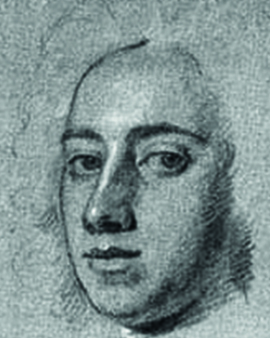Thomas Hudson was a British portrait painter and art collector. At the peak of his career he was considered a "portraitist of the British establishment". Later his portrait style was to go out of fashion thanks to his own student, so that he gave up painting long before his death.
Thomas Hudson was born in England in 1701. He learned painting under portrait painter Jonathan Richardson. At the age of 24 he married Richardson's daughter, allegedly against his own will. Within the next few years Hudson should rise to one of the most famous artists of his time. From about 1745 to 1755, he was widely regarded as the most successful portrait painter in London. He profited so much from the emerging fashion of portraiture that he had to employ several people in his studio in order to handle the large number of commissions. In total, he painted about 400 portraits during this period, 80 of which were processed as copperplate engravings. For his wedding Hudson was in the highest English society. He was a portraitist of the royal house around George II, but also painted portraits of the court nobility, church princes and scholars as well as actors and musicians. From the latter, the only two surviving portraits of George Frideric Handel's old age can be deduced. Hudson is said to have painted about 15 portraits of Handel.
Considered a portrait painter nationwide, Hudson counted a number of famous painters among his students. Joshua Reynolds, Joseph Wright of Derby, and Thomas Jenkins, among others, were among his students. Reynolds developed his own style of portraiture. Over the years this led to Hudson's style itself going completely out of fashion. As a consequence, Hudson gave up painting in 1767 and from then on concentrated on his art collection.
Towards the end of his life, Hudson was physically a strange figure, but remained in good spirits. William Hickey, an English lawyer, who became particularly famous for his extensive memoirs, described old Hudson as follows: "His character was quite grotesque. He was unusually short, had an amazing belly and wore a large white bushy wig all the time. He was remarkably cheerful and one of my absolute favorites, although he often told me I should be hanged by all means." Hudson finally died in 1779. After his death his remarkable art collection was sold at several London auctions.
×





_Countess_of_Egmont_and_her_Eldest_Son_Char_-_(MeisterDrucke-179619).jpg)
_Countess_of_Egmont_and_her_Eldest_Son_Char_-_(MeisterDrucke-179619).jpg)
.jpg)
.jpg)
.jpg)
.jpg)
.jpg)
.jpg)
_-_(MeisterDrucke-1315557).jpg)
_-_(MeisterDrucke-1315557).jpg)
_actor_and_vocalist_-_(MeisterDrucke-163423).jpg)
_actor_and_vocalist_-_(MeisterDrucke-163423).jpg)
.jpg)
.jpg)
_c1736_-_(MeisterDrucke-240167).jpg)
_c1736_-_(MeisterDrucke-240167).jpg)
_engraved_by_William_Bromley_(1769-1842)_for_-_(MeisterDrucke-279836).jpg)
_engraved_by_William_Bromley_(1769-1842)_for_-_(MeisterDrucke-279836).jpg)
.jpg)
.jpg)
_-_(MeisterDrucke-1093984).jpg)
_-_(MeisterDrucke-1093984).jpg)
.jpg)
.jpg)
_(oil_on_canvas)_-_(MeisterDrucke-1132871).jpg)
_(oil_on_canvas)_-_(MeisterDrucke-1132871).jpg)
.jpg)
.jpg)
.jpg)
.jpg)
.jpg)
.jpg)
_engraved_by_Charles_Edward_Wagstaff_(b1808)_-_(MeisterDrucke-216523).jpg)
_engraved_by_Charles_Edward_Wagstaff_(b1808)_-_(MeisterDrucke-216523).jpg)
.jpg)
.jpg)
.jpg)
.jpg)
.jpg)
.jpg)
.jpg)
.jpg)
_-_(MeisterDrucke-69747).jpg)
_-_(MeisterDrucke-69747).jpg)
_-_(MeisterDrucke-1643856).jpg)
_-_(MeisterDrucke-1643856).jpg)
_-_(MeisterDrucke-907036).jpg)
_-_(MeisterDrucke-907036).jpg)
_-_(MeisterDrucke-192373).jpg)
_-_(MeisterDrucke-192373).jpg)
.jpg)
.jpg)
.jpg)
.jpg)
_-_(MeisterDrucke-964673).jpg)
_-_(MeisterDrucke-964673).jpg)
.jpg)
.jpg)
_1764_(mezzotint)_-_(MeisterDrucke-307379).jpg)
_1764_(mezzotint)_-_(MeisterDrucke-307379).jpg)
_-_(MeisterDrucke-1507958).jpg)
_-_(MeisterDrucke-1507958).jpg)
.jpg)
.jpg)
_Clockmaker_engraved_by_John_Faber_(1684-17_-_(MeisterDrucke-259540).jpg)
_Clockmaker_engraved_by_John_Faber_(1684-17_-_(MeisterDrucke-259540).jpg)
.jpg)
.jpg)
.jpg)
.jpg)
_actress_and_singer_engraved_by_John_Faber_(1684_-_(MeisterDrucke-310016).jpg)
_actress_and_singer_engraved_by_John_Faber_(1684_-_(MeisterDrucke-310016).jpg)
_(mezzotint)_-_(MeisterDrucke-117721).jpg)
_(mezzotint)_-_(MeisterDrucke-117721).jpg)
.jpg)
.jpg)
.jpg)
.jpg)
.jpg)
.jpg)
.jpg)
.jpg)
.jpg)
.jpg)
_1760_-_(MeisterDrucke-270170).jpg)
_1760_-_(MeisterDrucke-270170).jpg)
_actress_and_singer_engraved_by_John_Faber_(1684_-_(MeisterDrucke-68614).jpg)
_actress_and_singer_engraved_by_John_Faber_(1684_-_(MeisterDrucke-68614).jpg)
.jpg)
.jpg)
.jpg)
.jpg)
.jpg)
.jpg)
.jpg)
.jpg)
.jpg)
.jpg)
.jpg)
.jpg)
_-_(MeisterDrucke-1374947).jpg)
_-_(MeisterDrucke-1374947).jpg)
.jpg)
.jpg)
.jpg)
.jpg)
_-_(MeisterDrucke-1374508).jpg)
_-_(MeisterDrucke-1374508).jpg)
.jpg)
.jpg)
.jpg)
.jpg)
_c1735_-_(MeisterDrucke-278489).jpg)
_c1735_-_(MeisterDrucke-278489).jpg)
_-_(MeisterDrucke-1114073).jpg)
_-_(MeisterDrucke-1114073).jpg)
_-_(MeisterDrucke-1636277).jpg)
_-_(MeisterDrucke-1636277).jpg)
_-_(MeisterDrucke-1457954).jpg)
_-_(MeisterDrucke-1457954).jpg)
_-_(MeisterDrucke-921798).jpg)
_-_(MeisterDrucke-921798).jpg)
.jpg)
.jpg)
.jpg)
.jpg)
_-_(MeisterDrucke-1457864).jpg)
_-_(MeisterDrucke-1457864).jpg)
.jpg)
.jpg)
.jpg)
.jpg)
.jpg)
.jpg)
.jpg)
.jpg)
.jpg)
.jpg)
.jpg)
.jpg)
.jpg)
.jpg)
.jpg)
.jpg)
.jpg)
.jpg)
.jpg)
.jpg)
_-_(MeisterDrucke-1501442).jpg)
_-_(MeisterDrucke-1501442).jpg)
.jpg)
.jpg)
.jpg)
.jpg)
.jpg)
.jpg)
_-_(MeisterDrucke-1130767).jpg)
_-_(MeisterDrucke-1130767).jpg)
.jpg)
.jpg)
.jpg)
.jpg)
.jpg)
.jpg)
.jpg)
.jpg)
.jpg)
.jpg)
_-_(MeisterDrucke-1461692).jpg)
_-_(MeisterDrucke-1461692).jpg)
.jpg)
.jpg)
.jpg)
.jpg)
.jpg)
.jpg)
.jpg)
.jpg)
.jpg)
.jpg)
.jpg)
.jpg)
_-_(MeisterDrucke-1088895).jpg)
_-_(MeisterDrucke-1088895).jpg)
.jpg)
.jpg)
.jpg)
.jpg)
.jpg)
.jpg)
_-_(MeisterDrucke-1457833).jpg)
_-_(MeisterDrucke-1457833).jpg)
.jpg)
.jpg)
_-_(MeisterDrucke-1499173).jpg)
_-_(MeisterDrucke-1499173).jpg)
_1749_-_(MeisterDrucke-265277).jpg)
_1749_-_(MeisterDrucke-265277).jpg)
.jpg)
.jpg)






